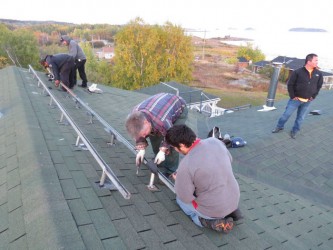Article Origin
Volume
Issue
Year
The next time the lights go out because of a glitch in Fort Chipewyan’s power plant, the Elders and youth lodge will be lit up like a beacon thanks to solar energy.
“Not everybody has wood burning stoves, so if we lose power, we can bring the Elders here,” said Greg Adams, with Athabasca Chipewyan First Nation’s Housing and Special Projects. The solar panels would keep electricity in the lodge for 72 hours.
The lodge, which was formerly a home and now serves as a community centre with a kitchen and meeting room, has eight solar panels on the roof which feed into 16 six-volt batteries to store power.
Establishing a solar panel pilot project in the community has been three years in the making, says Jesse Cardinal, coordinator with the Keepers of the Athabasca.
The Keepers board chose Fort Chip for a number of reasons, says Cardinal, including its isolation, the high cost of diesel, and the direct impact of tarsands development.
“If we’re telling people there’s a timeline to fossil fuels and to show them how destructive it is, what are we telling them to do instead?” said Cardinal. “Now as Keepers, we’re finally able to spend some time on solutions as well.”
Keepers received funding from the Pembina Institute and Centre for Indigenous Environmental Resources to undertake an energy baseline audit to get a handle on current community energy usage as well as climate and region.
EcoTrust and Glasswaters Foundation brought the project up to the point of installation.
Part of the three-year process included education, says Cardinal, with people taught to conserve energy and made aware of how much energy can be used at a single time when solar power is involved.
It was an option the community embraced, says Adams, who notes that hunters and trappers are considering solar energy for their cabins.
Now that the project is operational, Keepers of the Athasbasca will continue to lend support, but the future of solar energy for the ACFN lies in the hands of the newly created Fort Chipewyan Renewable Society. Keepers will now move on to help other Indigenous communities interested in green energy, including wind power.
“We do feel that the Indigenous people will help lead the way in helping people understand what a sustainable future can look like,” said Cardinal.
The cost of installing the panels on the lodge was under $20,000.
Adams says discussions are already underway with Direct Energy. The intention is to have the solar power not used by the lodge fed into the power grid and made available to the community.
“We get a credit of this from Direct Energy in the future,” said Adams.
He adds that three people, one each from ACFN, Mikisew Cree Nation and Fort Chipewyan Métis Local, have been trained by Edmonton electrician Jerry Paschen and his son, who installed the solar panels on the lodge. The new trainees will be in charge of installing more solar panels, which will be inspected by Paschen.
Adams is optimistic that solar energy can become a viable option in cases of power emergencies. He’s also confident that other First Nations will soon be in touch with ACFN to find out more about the green energy source.
- 1392 views

